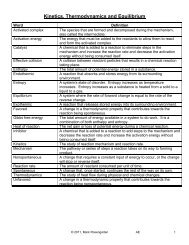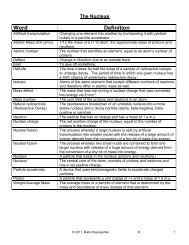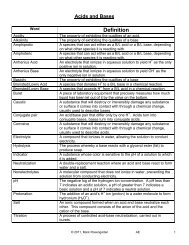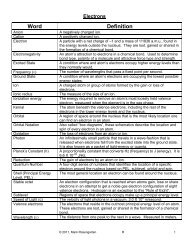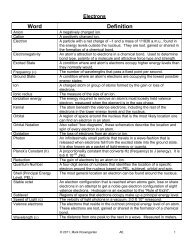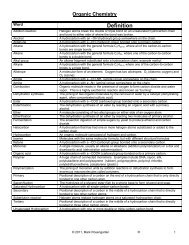Unit 4 - Mark Rosengarten
Unit 4 - Mark Rosengarten
Unit 4 - Mark Rosengarten
Create successful ePaper yourself
Turn your PDF publications into a flip-book with our unique Google optimized e-Paper software.
This diagram shows the path taken by radioactive particles as they pass through an electric field. On the left is a<br />
shielded container that holds a sample of radioactive substance, with a small hole at the end to allow decay particles to<br />
stream out in a straight line. Above and below the stream are electrically charged plates, which deflect (change the<br />
path of) the beams as they come out. Positive-charged particles (like alpha and positron) are attracted to the<br />
negatively charged plate. Negative-charged particles (like beta) are attracted to the positively charged place. The<br />
gamma rays, having no charge, pass through undeflected. On the right side is a screen that has been coated with zinc<br />
sulfide (ZnS), which is a phosphor (material that glows when energized particles hit it). ZnS is used as a phosphor<br />
coating on television sets with picture tubes and CRT (cathode ray tube) computer monitors.<br />
Proton/Neutron Ratio: The ratio of n:p in a stable atom varies with size. Small atoms are stable at a 1:1 ratio. As<br />
the atom becomes larger, more neutrons are needed for stability, driving the stable n:p ratio as high as 1.5:1. This<br />
creates a zone of stability, inside of which the isotopes are stable. Outside the zone, nuclei either have too many or<br />
too few neutrons to be stable, and therefore decay by emitting α, β − or γ particles to bring the ratio back to the zone of<br />
stability. ALL ISOTOPES OF ALL ELEMENTS ABOVE Bi ARE UNSTABLE AND UNDERGO RADIOACTIVE DECAY.<br />
© 2011, <strong>Mark</strong> <strong>Rosengarten</strong> AE 6



